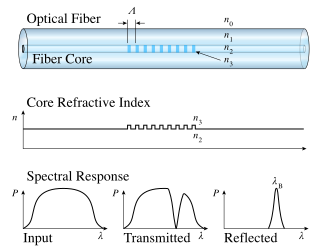
In fiber optics, polarization-maintaining optical fiber is a single-mode optical fiber in which linearly polarized light, if properly launched into the fiber, maintains a linear polarization during propagation, exiting the fiber in a specific linear polarization state; there is little or no cross-coupling of optical power between the two polarization modes. Such fiber is used in special applications where preserving polarization is essential.

In fiber-optic communication, a single-mode optical fiber (SMF) is an optical fiber designed to carry light only directly down the fiber - the transverse mode. Modes are the possible solutions of the Helmholtz equation for waves, which is obtained by combining Maxwell's equations and the boundary conditions. These modes define the way the wave travels through space, i.e. how the wave is distributed in space. Waves can have the same mode but have different frequencies. This is the case in single-mode fibers, where we can have waves with different frequencies, but of the same mode, which means that they are distributed in space in the same way, and that gives us a single ray of light. Although the ray travels parallel to the length of the fiber, it is often called transverse mode since its electromagnetic oscillations occur perpendicular (transverse) to the length of the fiber. The 2009 Nobel Prize in Physics was awarded to Charles K. Kao for his theoretical work on the single-mode optical fiber.

In the field of optics, transparency is the physical property of allowing light to pass through the material without being scattered. On a macroscopic scale, the photons can be said to follow Snell's Law. Translucency is a superset of transparency: it allows light to pass through, but does not necessarily follow Snell's law; the photons can be scattered at either of the two interfaces, or internally, where there is a change in index of refraction. In other words, a translucent medium allows the transport of light while a transparent medium not only allows the transport of light but allows for image formation. Transparent materials appear clear, with the overall appearance of one color, or any combination leading up to a brilliant spectrum of every color. The opposite property of translucency is opacity.
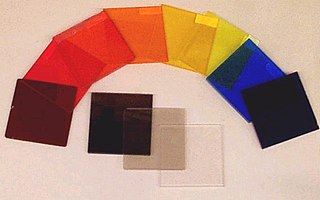
An optical filter is a device that selectively transmits light of different wavelengths, usually implemented as a glass plane or plastic device in the optical path, which are either dyed in the bulk or have interference coatings. The optical properties of filters are completely described by their frequency response, which specifies how the magnitude and phase of each frequency component of an incoming signal is modified by the filter.
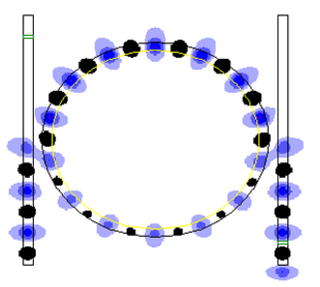
An optical ring resonator is a set of waveguides in which at least one is a closed loop coupled to some sort of light input and output. The concepts behind optical ring resonators are the same as those behind whispering galleries except that they use light and obey the properties behind constructive interference and total internal reflection. When light of the resonant wavelength is passed through the loop from input waveguide, it builds up in intensity over multiple round-trips due to constructive interference and is output to the output bus waveguide which serves as a detector waveguide. Because only a select few wavelengths will be at resonance within the loop, the optical ring resonator functions as a filter. Additionally, as implied earlier, two or more ring waveguides can be coupled to each other to form an add/drop optical filter.

Photonic-crystal fiber (PCF) is a class of optical fiber based on the properties of photonic crystals. It was first explored in 1996 at University of Bath, UK. Because of its ability to confine light in hollow cores or with confinement characteristics not possible in conventional optical fiber, PCF is now finding applications in fiber-optic communications, fiber lasers, nonlinear devices, high-power transmission, highly sensitive gas sensors, and other areas. More specific categories of PCF include photonic-bandgap fiber, holey fiber, hole-assisted fiber, and Bragg fiber. Photonic crystal fibers may be considered a subgroup of a more general class of microstructured optical fibers, where light is guided by structural modifications, and not only by refractive index differences.
Arrayed waveguide gratings (AWG) are commonly used as optical (de)multiplexers in wavelength division multiplexed (WDM) systems. These devices are capable of multiplexing a large number of wavelengths into a single optical fiber, thereby increasing the transmission capacity of optical networks considerably.
An optical waveguide is a physical structure that guides electromagnetic waves in the optical spectrum. Common types of optical waveguides include optical fiber and rectangular waveguides.

Double-clad fiber (DCF) is a class of optical fiber with a structure consisting of three layers of optical material instead of the usual two. The inner-most layer is called the core. It is surrounded by the inner cladding, which is surrounded by the outer cladding. The three layers are made of materials with different refractive indices.
A fiber laser or fibre laser is a laser in which the active gain medium is an optical fiber doped with rare-earth elements such as erbium, ytterbium, neodymium, dysprosium, praseodymium, thulium and holmium. They are related to doped fiber amplifiers, which provide light amplification without lasing. Fiber nonlinearities, such as stimulated Raman scattering or four-wave mixing can also provide gain and thus serve as gain media for a fiber laser.
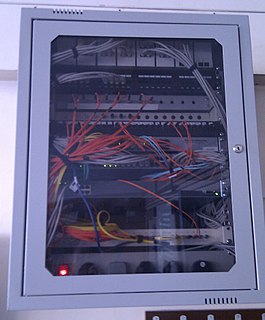
Fiber-optic communication is a method of transmitting information from one place to another by sending pulses of light through an optical fiber. The light forms an electromagnetic carrier wave that is modulated to carry information. Fiber is preferred over electrical cabling when high bandwidth, long distance, or immunity to electromagnetic interference are required.
A distributed feedback laser (DFB) is a type of laser diode, quantum cascade laser or optical fiber laser where the active region of the device contains a periodically structured element or diffraction grating. The structure builds a one-dimensional interference grating and the grating provides optical feedback for the laser. This longitudinal diffraction grating has periodic changes in refractive index that cause reflection back into the cavity. The periodic change can be either in the real part of the refractive index, or in the imaginary part. The strongest grating operates in the first order - where the periodicity is one-half wave, and the light is reflected backwards. DFB lasers tend to be much more stable than Fabry-Perot or DBR lasers and are used frequently when clean single mode operation is needed, especially in high speed fiber optic telecommunications. Semiconductor DFB lasers in the lowest loss window of optical fibers at about 1.55um wavelength, amplified by Erbium-doped fiber amplifiers (EDFAs), dominate the long distance communication market, while DFB lasers in the lowest dispersion window at 1.3um are used at shorter distances.
Guided-mode resonance or waveguide-mode resonance is a phenomenon wherein the guided modes of an optical waveguide can be excited and simultaneously extracted by the introduction of a phase-matching element, such as a diffraction grating or prism. Such guided modes are also called "leaky modes", as they do not remain guided, and have been observed in one and two-dimensional photonic crystal slabs.
Chiral Photonics, Inc. is a photonics company based in Pine Brook, New Jersey, founded in 1999. The company is developing a new class of optical devices based on twisting glass optical fibers. These in-fiber devices aim to displace discrete optical elements such as lasers, filters and sensors. They benefit from optical fiber’s transmission efficiency, robustness and ease of integration.
A fiber optic sensor is a sensor that uses optical fiber either as the sensing element, or as a means of relaying signals from a remote sensor to the electronics that process the signals. Fibers have many uses in remote sensing. Depending on the application, fiber may be used because of its small size, or because no electrical power is needed at the remote location, or because many sensors can be multiplexed along the length of a fiber by using light wavelength shift for each sensor, or by sensing the time delay as light passes along the fiber through each sensor. Time delay can be determined using a device such as an optical time-domain reflectometer and wavelength shift can be calculated using an instrument implementing optical frequency domain reflectometry.
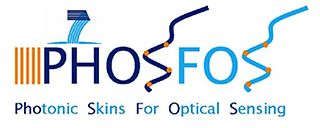
PhoSFOS is a research and technology development project co-funded by the European Commission.
Cladding in optical fibers is one or more layers of materials of lower refractive index, in intimate contact with a core material of higher refractive index. The cladding causes light to be confined to the core of the fiber by total internal reflection at the boundary between the two. Light propagation in the cladding is suppressed in typical fiber. Improving transmission through fibers by applying a cladding was discovered in 1953 by Dutch scientist Bram van Heel. Some fibers can support cladding modes in which light propagates in the cladding as well as the core.
In physics, a high contrast grating is a single layer near-wavelength grating physical structure where the grating material has a large contrast in index of refraction with its surroundings. The term near-wavelength refers to the grating period, which has a value between one optical wavelength in the grating material and that in its surrounding materials.


